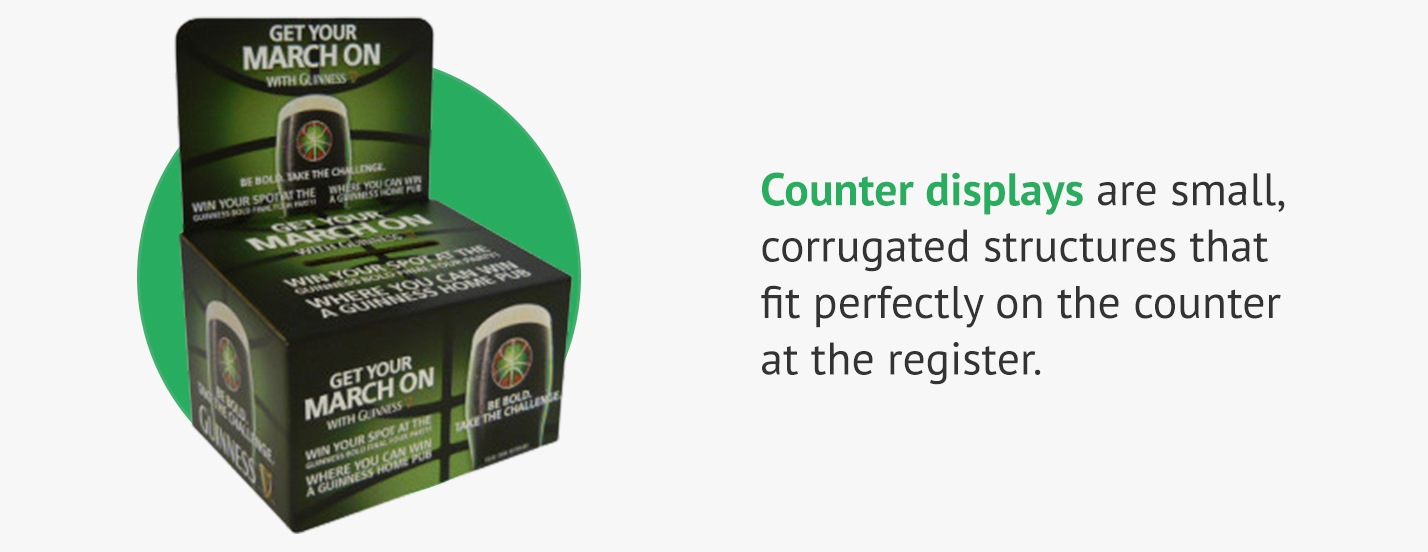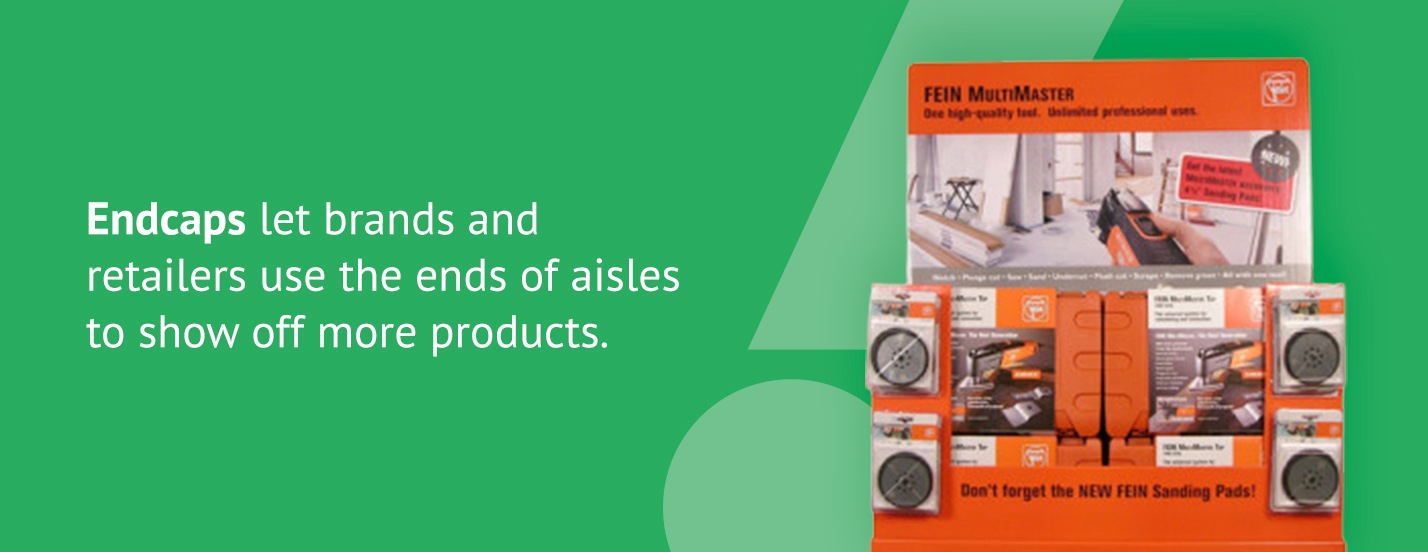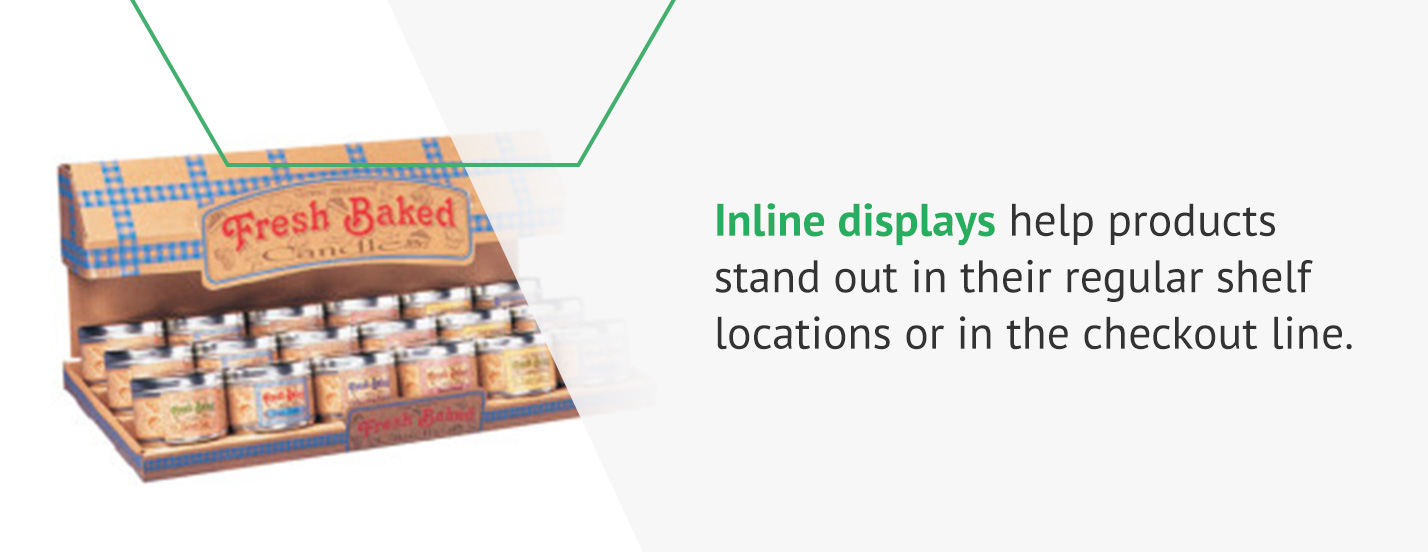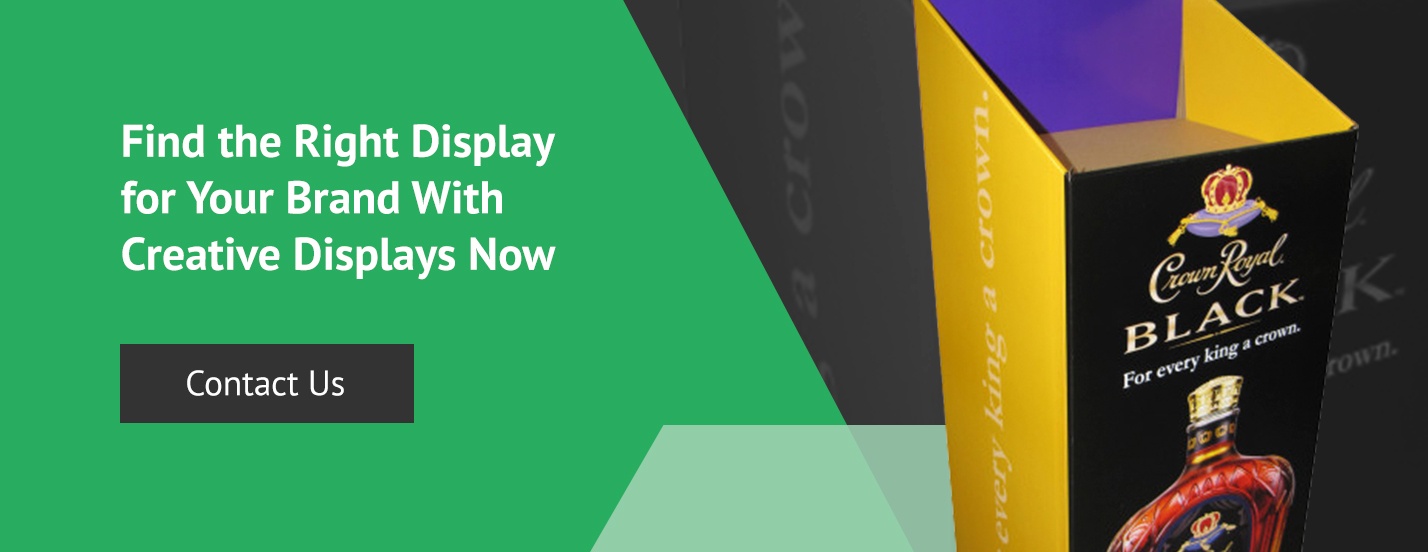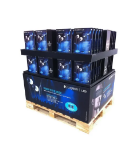Retail displays come in all shapes and sizes. Some types of displays are best suited for particular product categories, while others are best for specific retail environments. A spacious club store may have room for a larger setup, while a small convenience store may only allow for low-profile inline displays with smaller footprints.
After accounting for your retail partner’s requirements, you have a few more considerations. A heavier or high-turnover product will need a larger structure that’s sturdy enough to support the products. Likewise, exhibiting several items will require a display with enough room to let each product shine. Space-saving and low-profile display designs usually work best with smaller goods.
Next, you’ll want to consider the locations available within the stores where you want to showcase your products. Some displays are shaped and sized for particular retail locations. Additionally, some areas of the store are known for being particularly effective for sales because they offer high visibility and more foot traffic. To take advantage of these most coveted locations, you’ll need the correct type of display.
With all the different options available, you might still be unsure which type of display to choose. To help you select your product displays, we’ve created this overview of the different types of temporary cardboard retail displays. Take a look at our retail display options, how they’re used and the products they’re most suited for.
Use this menu to learn more about the different types of retail displays:
- Floor Displays
- Counter Displays
- Pallet Displays
- Retail Signage
- Endcap Displays
- Power Wing and Sidekick Displays
- Display Bins and Case Stackers
- Inline Displays
- Brochure Holders
- Counter Shipper Displays
- Find the Right Display for Your Brand With Creative Displays Now
Floor Displays
A floor display, or floor stand, is a retail structure that stands freely on the floor. They usually rise to around shoulder height and may stretch even taller. This height makes them stand out at eye-level and jump out along the horizon in a busy retail environment. Floor stands are highly customizable and can take on many shapes and footprints. Structural ingenuity, novelty and eye-catching graphics make floor displays and their products stand out in high-traffic locations.
One of the main advantages of a floor display is its presence. They take up a lot of vertical space and can have a footprint as large as a standard wooden pallet or even larger. Their size makes them more visible and excellent for promoting brand awareness and impulse purchases.
Made of corrugated cardboard, these stands are lightweight and easy to move. Still, they’re sturdy and long-lasting. You’ll often find floor displays floating in the center of wide main corridors, at the ends of aisles or by checkout lanes. There are several types of floor displays, including:
- Dump bins.
- Pallet displays.
- Peg hooks.
- Gondolas.
- Case stackers.
- Shelves.
- Cardboard standees.
Really, “floor display” is a general term for the various types of displays that sit on the floor rather than on a countertop or shelf.
Because they can take on many shapes, sizes and designs, they’re well suited for many types of products. Boxed or other uniformly-shaped items that can fit nicely on shelves or slots are a great fit. Lightweight products that can hang on pegs, like gift cards, also work well with floor displays. They’re an excellent option for product categories including:
- Lightweight hardware and tools.
- Consumer electronics.
- Pet food and supplies.
- Food and beverages.
- Office and school supplies.
- Cosmetics and personal hygiene products.
- Toys.
Counter Displays
Counter displays are small, corrugated structures that fit perfectly on the counter at the register. They can also find homes at customer service desks and pharmacy windows. Their main advantage is that they’re right in front of customers as they’re getting ready to pay. Every customer who makes a purchase will see the counter display right at eye level as they’re checking out. They typically have slots for holding merchandise and a backboard that offers branding opportunities.
Because they’re small and have a prominent location, counter displays are a cost-effective way to promote products. They can also encourage impulse buys and increase awareness for new products.
It’s important to remember that customers of all kinds will stop by the register. For that reason, counter displays are well suited for small essentials and wide-appeal items rather than niche markets. Some excellent candidates for countertop displays include:
- Candies and snacks.
- Small toys or stickers.
- Small cosmetic items.
- Travel-sized items.
- Seasonal and holiday products.
- Gift cards.
Pallet Displays
Pallet displays are a type of floor display that rests on a pallet rather than on the floor. You’ll commonly find pallet displays in larger, spacious retail environments. They’re popular for big-box club stores and large grocery stores. Because they have a sturdy pallet for support, they can hold larger quantities and heavier products.
The pallet also improves accessibility, making even heavy displays easy to move with a pallet truck’s help. Since they fit onto standard pallets, they’re also relatively simple to assemble. This feature is useful because it saves time if you do your own assembly, and increases compliance when retailers assemble them.
Shoppers can access a full pallet display from all four sides. They’re quite large, so your brand can stock a variety of products on a single structure. Showcase several colors or flavors, a main product alongside its accessories or a complete health and beauty regimen. The high capacity of pallet displays makes them excellent for high-volume, high-turnover products.
Instead of a full pallet, some brands may choose a half-pallet or quarter-pallet display. These cost-effective options save space and money. However, these smaller pallets won’t provide visibility from all four sides. For another branding opportunity, consider a printed pallet skirt. These graphics cover up the wood pallet supporting your display, increasing visual appeal.
The best products for a pallet display include:
- Food and beverage items.
- Technology devices.
- Fresh produce.
- Seasonal products.
- Home improvement tools.
Retail Signage
Not all retail displays need to showcase products themselves. Retail signage is an affordable way to draw attention to items stocked on a store’s regular shelves. They can also be situated near a product display, increasing visibility and letting customers see your brand messages from many angles. They feature enticing language and attractive imagery to point shoppers toward your products. They can range from full-sized cardboard cutouts to low-profile signs attached to a shelf.
Retail signage can take many forms, including:
- Ceiling-hung signs: Signs hanging from a ceiling can draw more attention to a cardboard display or products shelved below. They’re inexpensive and don’t require floor space.
- Shelf talkers: Small signs that hang off of aisle shelves point shoppers directly to where your products are shelved. They are a low-cost way to increase visibility, and they don’t need floor space.
- Floor signs: Cardboard standees, or even three-dimensional structures resembling free-standing product displays, offer the greatest visibility and coverage. These take up floor space.
Endcap Displays
A coveted display location in any store is the ends of aisles. Endcaps let brands and retailers use the ends of aisles to show off more products. Retailers love them because their visual appeal can draw more customers down an aisle.
Brands also love them because more shoppers will pass by an endcap than will enter a particular aisle. You can gain visibility even from customers who weren’t planning on stopping at a particular section. In grocery stores, many shoppers stick to the perimeter and won’t enter the aisles. As a response to this behavior, endcaps promote items typically shelved in interior aisles. Meanwhile, those who enter an aisle must walk directly past the endcap display.
Some endcaps are floor displays, taking up the entire vertical space available next to a row of shelves. You can also choose a smaller inline endcap designed to fit on a shelf at the end of the aisle. Half pallets can fit in the endcap position as well, letting you stock products in larger quantities. Endcap displays are great for new items, best sellers and other featured products. Retailers may also use them for sale or clearance items.
It’s best to match the products in your endcap to the store section or department. For example, a cosmetics endcap display will do best in the health and beauty aisle, and back-to-school endcap displays will stand out in the office supply section.
Power Wing and Sidekick Displays
Similar to an endcap, a power wing is situated at the end of an aisle. They’re often called sidekick displays because they flank a traditional endcap and sit parallel to the shelving rather than perpendicular to it. They offer excellent visibility, although not quite as much as a front-facing endcap.
Some sidekicks are half-size and will exhibit a small collection of products at eye-level. Others are narrow, displaying a single vertical column of small merchandise, sometimes called a clip strip. Full-sized power wings can be the same size as an endcap and can feature a few short rows of products. Sometimes, they come with a base that lets a retailer use them as a floor stand. Otherwise, they hang off the ends of aisles at eye level. They usually come pre-assembled and pre-stocked so all the retailer has to do is put them out.
Power wings provide a secondary location for items outside their regular home in store aisles. They’re great for new products, current promotions and featured items. In general, sidekicks are suitable for smaller and lightweight items. Some products most often displayed in power wings include:
- Small electronics.
- Over-the-counter pharmacy products.
- Magazines and books.
- Sample-sized beverages or other products.
- Cosmetics and hair care products.
Display Bins and Case Stackers
A type of floor display, a case stacker or display bin is for rectangular and easy-to-stack items. They’re essentially a graphic wrap that adds visual appeal to stacked cases of products. They’re popular in the beverage industry, which uses them to house cases of soft drinks, energy drinks, beer and wine. Outside of food and beverage products, a case stacker can showcase a wide variety of uniformly-sized items without any slots, hooks or shelves.
A variation on the case stacker, the dump bin, is another way to house items without shelves or hanging pegs. The difference is that a dump bin is intentionally more disorganized. It’s a large, sometimes oversized cardboard bin that can hold large quantities of small products. Retail employees can stock a dump bin easily by simply adding items to the pile. Some dump bins feature dividers that allow for better organization.
Retailers often use dump bins for sale merchandise, items that are going out of season and unsold stock. They’re an excellent way for a retailer to make room for a new product.
Dump bins also create a kind of treasure hunt for shoppers. Customers can spend a few minutes rummaging through a dump bin to discover a great product at an even better price.
These displays can feature toys, DVDs, books, snacks and drinks, office supplies and more. While they’re often associated with sale and clearance items, a creative design can make a featured item or best-seller stand out.
Inline Displays
Inline displays help products stand out in their regular shelf locations or in the checkout line. Sometimes, stores do not allow their brands to use freestanding displays or take up any floor space. Instead, brands must display their products on their regular shelves, among a sea of competitors. Here, a creative inline display concept lets a brand differentiate its products from the surrounding ones.
Certain stores only allow displays that will fit conveniently on shelves. If that’s the case for your retail partners, an inline display is your best option. They can also be more cost-effective than floor displays. Since inline displays will be placed close to other brands in the product category, they have a high chance of being seen by shoppers looking for those particular products. They offer a prominent display in high traffic areas, with an excellent location for attracting your target audience.
Small, easy-to-grab items alongside enticing products like snacks, candy and magazines are great fits.
Brochure Holders
While most displays feature consumer packaged goods, all brands can take advantage of the retail landscape. Brands promoting services or products not sold in stores can use a brochure holder to improve their out-of-home marketing. They’re great for travel agencies, pharmaceuticals, health care services and B2B companies. Some brochure holders feature a single pocket to keep your pamphlet at the center of attention. Others contain multiple pockets to showcase several products or services with their own booklets.
While effective brochures and pamphlets are attention-grabbing on their own, a branded brochure holder gives them more visibility. They extend the area usually taken up by a narrow booklet, drawing the eye toward it. They also improve organization, making sure brochures stay in a neat row or stack. Besides the checkout counter, brochure holders can go in many locations. They’re ideal for traditional retail and non-retail environments alike. Display them at pharmacy windows, trade shows, conventions, airports, hotels, banks, doctors’ offices, reception desks or anywhere you choose.
Counter Shipper Displays
A counter shipper is a type of small counter display that ships to a retailer and requires minor assembly. The shipper first serves as a package and is sturdy enough to protect products in transit. When retailers unpack the shipment, the box it came in doubles as a display case. Retailers can quickly assemble them to create small displays with backboards and sometimes shelves, risers or slots to hold products.
Shipper displays feature tearaway, die-cut risers, or perforated panels for slots. The simple, elegant design lets store employees quickly assemble them. The bottom of the box doubles as the base, and the tearaway walls become a wrap-around product tray. They’re a popular option because of their efficiency. You can reuse the same cardboard from the packaging as a marketing display in the retail environment. This feature minimizes material usage, saving you money while helping the planet. When a counter shipper wears out or becomes damaged, a retailer can replace it with another from their current stock.
While they’re called counter shippers, you can also display them on shelves in the checkout aisle or throughout the store. As with the counter and inline varieties, these displays are best for small, easy-to-grab items.
Find the Right Display for Your Brand With Creative Displays Now
As long-time POP display experts, we love helping our clients get started with retail displays. We understand all the different display types and their nuances, along with shopper insights and major retailers’ requirements. Take advantage of our expertise to help you get the most out of your displays. We’re happy to make recommendations and answer your questions about the store display types you’re considering. For truly outstanding displays, our team of 60+ talented structural designers will work to create something 100% custom for your products.
To get started, request your custom display estimate or call us today at 1-855-284-6922 and tell us about your vision and needs.


